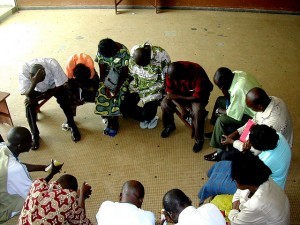Helping Christian Community Thrive: Drawing Close to God

 Team Prayer Contou, cc by Brian Kelley 2.0
Team Prayer Contou, cc by Brian Kelley 2.0If you call your faith “a personal relationship to God” you already know it is true: You should be drawing close to God. How can you say you have a relationship that matters if the two of you don’t spend time together?
There’s a name for drawing close to God. It’s called praying.
Christians used to know how important prayer is. In Acts 2:42 it is the fourth key practice that marked the thriving early Christian community:
They devoted themselves to the apostles’ teaching and fellowship, to the breaking of bread and the prayers.” (Acts 2:42, NRSV)
In some denominations, and in some parts of the world, they still do know it. Take the churches in Korea where the passion is so strong they’ve been known to set aside a whole mountain as a place of prayer.
By the way, they are busting at the seems, those Korean churches.
You will hear people observe that congregations that grow and experience renewal have some things in common. Prayer is always on the list.
And it makes sense.
Prayer, conversation or communion with God, is the very substance of a relationship with God. No individual Christian can grow or thrive without it.
We need God’s help if we want our churches to grow and thrive. Prayer is where we ask him to act.
It’s a message most churches desperately need to hear.
I teach on prayer at a seminary, in online classes, and in churches. People often say their prayer life needs a lot of work. They lack confidence. They can’t work prayer into their schedules. They frankly don’t know how to start.
It is actually pretty rare to find people who have an active prayer life — a life-giving regular practice of drawing close to God, sharing all that is on their heart, and listening to God’s side of the conversation.
There are lots of excellent ways to get started in prayer. In my book Kneeling with Giants I detail ten of them, each with deep roots in a major branch of the Christian faith. (You can get a copy here.)
What is interesting to me is that the Acts community was not just committed to
prayer
but that they devoted themselves to
the prayers.
That is an interesting turn of phrase. It indicates some known set of prayers, written or oral. It is not how we Protestants talk about prayer today, because we assume all good and true prayer is spontaneous.
Not so for the first Christians.
So what were “the prayers” for the members of this first Christian community?
It is too soon for them to have had the liturgy — even if the Liturgy of St. James evolved early, it surely wasn’t rarin’ to go right after Christ’s ascension. But they had other resources.
They had the prayer Jesus taught them.
Jesus had said to the disciples
When you pray, say…
followed by what we know as the Lord’s Prayer. Surely they learned it by heart, even if Matthew and Luke disagree about the wording.
Surely they followed Jesus’ instruction and said exactly that prayer — or as Martin Luther would teach centuries later, maybe they used the lines of the Lord’s Prayer as topics for their meditations and confessions and intercessions.
Surely, though, they prayed “the prayer.”
They had the Psalms.
As well as the Lord’s Prayer they had the Old Testament. (Back then they just called it The Bible.) And part of the Bible is the book of prayers and hymns sung to God in worship: the Psalms.
Surely these Acts Christians, already knowing the Psalms, prayed them with new eyes and ears. On every page they would find traces of Jesus who had fulfilled the promises of the ancient texts.
Perhaps, like John Calvin fifteen centuries later, they studied the Psalms and found their own heart’s needs expressed as they prayed them.
Perhaps like the Desert Fathers and Mothers who would come in just a couple centuries, they memorized the Psalms and recited them as prayer.
One way or another they prayed “the prayers.”
They had the daily and Sabbath prayers from their Jewish upbringing.
The first Christians were, after all, Jews. Acts tells us they continued going to the Jerusalem temple and to synagogue. There, as Jews (Jews who had found the long-awaited Messiah) they prayed the Jewish prayers — which include lots and lots of Psalms.
I don’t know the history in detail, but Jewish people came to practice a cycle of regular daily prayer, morning, midday, and evening. Alone or in gatherings of a dozen or more, they would talk to God using “the prayers.”
Eventually they had the Divine Office.
Over time the Church evolved its own cycle of prayers, including the Lord’s Prayer and the Psalms.
You can find a modern version of the Office in the Catholic Liturgy of the Hours or the Anglican Book of Common Prayer.
If you try it, you’ll soon discover the advantages of praying “the prayers.” Even if you are praying alone in your living room, you’ll know that Christians around the world are also praying those same prayers at the same time.
You will be praying with the Church.
So what about communities?
Useful as these ways of praying are for individuals, this is not about your personal prayer life. This is about your Christian community’s prayer life.
One of the practices that helped the first Christian community thrive was a shared prayer life. They didn’t just individually pray a lot. They had something they all understood when they talked about “the prayers.”
Your Christian community needs a shared practice of prayer.
It is not enough that a few individuals are pillars of prayer. The leadership needs to teach a way of prayer.
————
Is prayer a struggle for you?
From time to time I offer classes based on the life-changing approaches to prayer in my award-winning book Kneeling with Giants (InterVarsity 2012).
Click the button and I’ll let you know when the next one is coming.
(This post contains affiliate links.)
The post Helping Christian Community Thrive: Drawing Close to God appeared first on Gary Neal Hansen.



